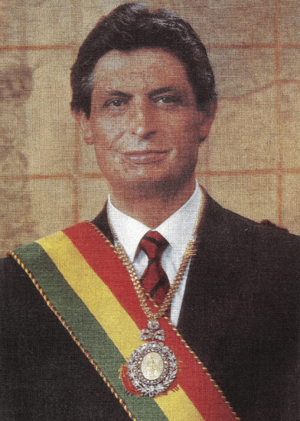Jaime Paz Zamora facts for kids
Quick facts for kids
Jaime Paz Zamora
OCA OSP gcYC
|
|
|---|---|

Official portrait by Antonio Eguino, 1989
|
|
| 60th President of Bolivia | |
| In office 6 August 1989 – 6 August 1993 |
|
| Vice President | Luis Ossio |
| Preceded by | Víctor Paz Estenssoro |
| Succeeded by | Gonzalo Sánchez de Lozada |
| 32nd Vice President of Bolivia | |
| In office 10 October 1982 – 14 December 1984 |
|
| President | Hernán Siles Zuazo |
| Preceded by | Luis Adolfo Siles Salinas |
| Succeeded by | Julio Garrett Ayllón |
| Personal details | |
| Born | 15 April 1939 Cochabamba, Bolivia |
| Political party |
|
| Other political affiliations |
Christian Democratic Party (2019) |
| Spouse | Carmen Pereira Carballo (divorced) |
| Children |
|
| Signature |  |
Jaime Paz Zamora, born on April 15, 1939, is a former politician from Bolivia. He was the 60th President of Bolivia from 1989 to 1993. Before that, he was the 32nd Vice President of Bolivia from October 1982 to December 1984, serving alongside President Hernán Siles Zuazo.
Contents
- Starting the Revolutionary Left Movement (MIR)
- Bolivia's Elections in the Late 1970s
- The 1980 Elections and a Difficult Time
- Serving as Vice President (1982–1985)
- Changes in Political Ideas (1985–1989)
- The 1989 Election and a New Alliance
- Jaime Paz Zamora's Presidency (1989–1993)
- Later Political Career
- Images for kids
- See also
Starting the Revolutionary Left Movement (MIR)
Jaime Paz Zamora studied in Belgium. In 1971, he helped start a political party called the Revolutionary Left Movement (MIR). This happened while he was exiled by the leader Hugo Banzer. The MIR quickly gained support from many young thinkers and university students.
In 1978, Paz's MIR formed an alliance with another party led by former President Hernán Siles Zuazo. This alliance was called the Unidad Democrática y Popular (UDP). It was a good partnership because Siles brought experience, while Paz brought the support of younger people.
Bolivia's Elections in the Late 1970s
The UDP took part in the June 1978 elections. They seemed to win the most votes. However, the election results were cancelled because of widespread fraud. New elections were held in 1979.
In 1979, Hernán Siles Zuazo and Paz, as his running mate, finished first. But they did not get the 50% of votes needed to win directly. So, it was up to the Bolivian Congress to choose the next president. The Congress could not agree on a candidate. Eventually, the head of the Senate, Dr. Wálter Guevara Arze, became temporary President. This led to another round of elections in 1980.
The 1980 Elections and a Difficult Time
The 1980 election campaign continued, even with threats from some military groups. In April 1980, a small plane carrying Paz and other politicians crashed. Everyone on board died except Paz. He recovered from his injuries and continued campaigning.
Siles Zuazo and Paz Zamora won the 1980 election. However, they could not take office right away. On July 17, 1980, General Luis García Meza led a military takeover. This stopped the democratic process for a while.
Serving as Vice President (1982–1985)
Paz went into exile but returned in 1982. By then, the military government was struggling, and Bolivia's economy was in trouble. To fix things, the results of the 1980 elections were finally recognized. In October 1982, Siles Zuazo became president, and Jaime Paz became his vice president.
The country faced very difficult economic times, including a period of very high inflation. President Siles found it hard to control the situation. The MIR party, led by Paz, decided to leave the government in 1984. This happened as Siles's popularity dropped very low.
Changes in Political Ideas (1985–1989)
By 1985, the government's struggles led Congress to call for early elections. Paz ran for president again and finished third. Víctor Paz Estenssoro became president from 1985 to 1989.
During this time, the MIR party changed its political ideas. Paz and other leaders decided to move away from some older socialist ideas. This change helped the party become more united and popular with voters.
The 1989 Election and a New Alliance
Paz ran for president again in May 1989. He finished third, close behind Gonzalo Sánchez de Lozada and former leader Hugo Banzer. Since no candidate won 50% of the votes, Congress had to choose the president.
Paz had previously said he would never work with Banzer. However, Banzer had a disagreement with Sánchez de Lozada's party. Paz then decided to form an alliance with Banzer. This alliance was called the "Patriotic Accord." On August 5, 1989, Congress elected Paz as president, thanks to Banzer's support. This alliance surprised many people.
Jaime Paz Zamora's Presidency (1989–1993)
Jaime Paz Zamora's time as president was generally successful. He worked with his alliance partner, Banzer. He focused on improving education, medical services, and general public services.
In foreign policy, Paz successfully negotiated for Bolivia to have access to a port on the Peruvian coast. This was important for Bolivia, which is a landlocked country. His presidency also helped restore unofficial relationships between Bolivia and Taiwan.
Later Political Career
After his presidency, the MIR party faced challenges. Paz supported Banzer in the 1993 elections, but Banzer was not elected by Congress. Gonzalo Sánchez de Lozada became president instead.
Paz ran for president again in 1997 and 2002, finishing fourth both times. The MIR's presence in Congress became much smaller. Paz's last election participation was in 2005 for a regional leadership position, which he lost.
Images for kids
See also
 In Spanish: Jaime Paz Zamora para niños
In Spanish: Jaime Paz Zamora para niños



